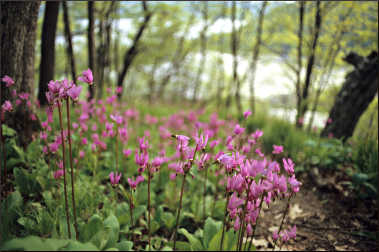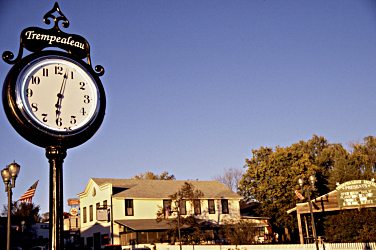Trails of Trempealeau
There's a lot to do in this Mississippi River hamlet in southwest Wisconsin.

© Beth Gauper
All kinds of paths cross in the Wisconsin village of Trempealeau.
Canoes and cormorants, tugboats and trains, bicyclists and blues fans all are drawn toward this Mississippi River town. It's just a little burg, but it's smack in the middle of Mother Nature's playground.
Perrot State Park starts at the end of Trempealeau's First Street, with hiking trails that give vistors spectacular views of far-off Winona, the river valley and a hill French explorers called La Montagne Qui Trempe a l'Eau, or "the mountain that soaks in the water."
To the north are the sloughs of Trempealeau National Wildlife Refuge, crossroads for birds and springboard for bicyclists.
The Great River State Trail starts there and heads south, through town and into Brice Prairie and the bottomlands of the Upper Mississippi River Wildlife and Fish Refuge.
There's great canoeing here, where the Black River empties into the Mississippi. Farther up, in Van Loon Wildlife Area, hikers can walk in Amazonian isolation along the four-mile McGilvray Road trail, where five rare bowstring-arch bridges cross red-tinted streams.
And the hub for all this activity is the 1871 Trempealeau Hotel, which was a bar when two La Crosse men stumbled into it in 1985 after skiing at Perrot State Park. It was rundown, but it had rows and rows of windows overlooking the Mississippi.
"I couldn't get it out of my little brain," said Jim Jenkins, the now-retired historical preservationist who bought the hotel with his friend, Bill King. "It was just too beautiful."
They replaced the Grain Belt with microbrews and the Beer Nuts with walnut burgers and alfalfa sprouts.
Then they decided to bring in live music. They used a friend's hay wagon as a stage, and Country Joe MacDonald became the first in a long line of outdoor performers.

© Beth Gauper
Jenkins sold the hotel in 2012 to Amy Werner, who had worked at the hotel while a young student at UW-La Crosse. And the music continues.
May and early June are great times to explore the Upper Mississippi, so I've been in town for the Blues Bash and Reggae Fest, where bands play to the accompaniment of tugboat horns and whistles from trains thundering by just yards away.
Musicians play on a picturesque little covered stage, flanked by pink peonies against a white picket fence. Fans listen in the shade of a big juniper and weeping willows, while children make sand castles on the volleyball court.
Once, I treated myself to a birthday weekend in the Doc West House, overlooking the music grounds and river. On my first morning, I rode my bike along the river, past the stone ruins of the Melchior brewery, left over from a cataclysmic fire in 1888, and into Perrot State Park.
Just inside the park is the post of Nicholas Perrot, a French fur trader who spent the winter of 1685-86 "at the foot of the mountain behind which was a great prairie abounding in wild beasts."
I climbed that mountain, at 520 feet one of the tallest bluffs on the Mississippi, and was rewarded with a magnificent view. The towers and domes of Winona gleamed 15 miles to the north, and below was Trempealeau Mountain, rising out of the water on a collar of limestone.
This island mountain and the adjoining bluffs were on the Minnesota side until the end of the last Ice Age, when silty meltwaters blocked the river's route and forced it to find a new channel.
From my aerie atop Brady's Bluff, eye to eye with lazily circling turkey vultures, I also saw what the last 100 years had wrought. Silos dotted the Minnesota blufftops and the Wisconsin flats.
Pontoons and speedboats sped by as a barge nosed its way down river. A freight train rumbled over the water of Trempealeau Bay on a narrow dike.
It was one of these railroad dikes that created Trempealeau Wildlife Refuge. When workers were driving bridge pilings in 1857, they couldn't find bottom and had to put the tracks farther north.

© Beth Gauper
The dikes they left protected the wetlands from river sediment and pollution, forming a refuge for migrating waterfowl. And the tracks, many years later, became one of Wisconsin's most scenic bike trails.
From the park, I rode onto the Great River State Trail and into the quiet refuge. There, the trail follows four miles of the Prairie's Edge Wildlife Drive, with 11 stations and a wooden observation deck on the river.
But the best sights can be seen while riding: a great blue heron, elegantly lifting off from a slough. Hillsides covered with purple lupine and wild rose. Turtles lined up on a fallen log.
The trail back into town is lined by meadows and the range of hazy blue peaks around Trempealeau Bay. There's a marked canoe trail there and also south of town, beyond Lock and Dam No. 6 at Long Lake Landing.
I had Trempealeau schoolteacher Al Bratberg, who ran a canoe service, take me there the next day so I could paddle the 5-mile Long Lake Canoe Trail loop.
"About when you get nervous about not knowing where to go, there'll be a little sign," he said, as I set off.
A heavy silence hung over the jungly backwater, and the air was filled with dragonflies. A couple fishing in the shade told me to start looking for bald eagles, but it was 90 degrees and they were nowhere to be seen.
Soon I came into the Mississippi, just up river from a barge that loomed in the horizon like an ocean liner.
I ducked back into the backwaters and rounded a corner past the eagles' nest and into Big Marsh Lake, then through the lily pads and back.
It took only 2½ hours, but it was time that felt far removed from civilization.

© Beth Gauper
Back at the Trempealeau Hotel, the signs of the Blues Bash had disappeared. Picnic tables were on stage where Cash McCall and Maurice John Vaughn had played. A basketball hoop stood where blues acolytes had danced under strands of Christmas lights, and bikes were parked all over the grass.
But there was still a crowd gazing out at the river panorama over lagers and fajitas, just around the corner from the hotel's vintage signs for "Peerless beer" and "Delicious food."
Thankfully, the important things don't change in Trempealeau.
Trip Tips: Trempealeau in southwest Wisconsin
Getting there: It's half an hour north of La Crosse.
When to go: In early May, Perrot State Park is full of spring ephemerals, including thousands of jeweled shooting stars, and bird-watching is excellent.
Summer is nice, but bring insect repellent in the sloughs. Fall is beautiful along the trails, and nearby orchards produce raspberries and apples.
Annual events: Early June, Reggae Fest. Mid-July, Catfish Days. First Saturday of October, Apple Affair in Galesville.

© Beth Gauper
Accommodations: The Trempealeau Hotel has two attractive suites in the newly renovated Doc West House next door, with whirlpool and gas stove. Above the restaurant are eight comfortable rooms that share one bath. Four motel rooms are near the dam.
Light sleepers who don't like train noise might prefer the nearby Little Bluff Inn. Some rooms have small refrigerators, microwaves or kitchenettes.
Perrot State Park has 104 campsites, 608-534-6409.
Dining: The screened porch of the Trempealeau Hotel is the place to be on a summer day. Try the famous walnut burgers and a microbrew.
Just down the road, next to Perrot State Park, Sullivan's Supper Club also has a view of the river and serves steaks, seafood, chops and ribs.
In town, the River Cafe serves hearty breakfasts and lunches.
Bicycling: From Wisconsin 35, the northern trailhead of the Great River State Trail is reached via the Marshland access of the Trempealeau National Wildlife Refuge, 8½ miles north of Trempealeau. The surface is finely crushed limestone pressed into hard dirt.
For more, see Bikes, birds and bogs.

© Beth Gauper
Trail passes cost $5 daily, $25 annual. In Onalaska, the Great River trail connects with the La Crosse River Trail, which connects with the Elroy-Sparta and 400 trails to provide 101 miles of trails.
Coulee Bicycle Company offers service in Onalaska.
Canoeing: The marked 4½-mile Long Lake Canoe Trail is part of the Upper Mississippi National Wildlife and Fish Refuge.
From Wisconsin 35 in Trempealeau, go south on Fremont Street (Lake Road) and continue past the railroad tracks for 1½ miles. The Long Lake Boat Landing marks the beginning and end of the canoe trail.
Canoes can be rented at Perrot State Park, which has marked a 2½- to 3-hour canoe trail in Trempealeau Bay.
Hiking: For a great loop in Perrot State Park, take the West Bluff Trail, lined with woodland flowers, up to Brady's Bluff. Return on the East Bluff Trail, lined with prairie flowers, and the Riverview Trail.
The four-mile McGilvray Road, seven miles east of Trempealeau, was a road to a town, now vanished, on the Black River. It's off Amsterdam Prairie Road, reached from 35 east or 53 north.
It's also nice in winter. For more, see Open sesame on the sloughs.
Information: Trempealeau tourism.